Wartime Heritage
ASSOCIATION


copyright © Wartime Heritage Association
Website hosting courtesy of Register.com - a web.com company
Robert Hampton Gray
Robert Hampton Gray enlisted in the summer of 1940. When an
opportunity to join the Royal Navy Fleet Air Arm as a pilot materialized,
he accepted. He flew Hurricanes and other aircraft for various Royal
Navy shore-based squadrons, and spent nearly two years in Africa.
In August 1944, Gray was assigned to 1841 RAF Squadron aboard
HMS Formidable as a Senior Pilot. In raids against the German
battleship Tirpitz he used a daring low-level attack. He had an ability
to remain relaxed despite heavy stress of combat
In 1945 HMS Formidable's assignment was the Pacific. On August
9, 1945, as the second atomic bomb fell on Nagasaki, the air war
against Japan targets continued unabated. Hammy Gray led two flights
of Corsairs on an attack against Japanese naval ships. As he levelled
out his Corsair, it was blasted with cannon and machine gun fire. The
aircraft was on fire, and one of his 500 lb. bombs was shot off. He
steadied the aircraft, and aimed his remaining bomb. This bomb hit the
target and sank the enemy ship.
Gray continued flying but brief seconds later his burning aircraft
hit the water at high speed, and broke up. Gray was killed, becoming
one of the last Canadians to die in combat in WWII. Despite the shock
of losing their Squadron Leader, and in spite of an order to make only
one run at each target, the remaining pilots conducted two more
successful attacks on the target Japanese ships.
Robert Hampton Gray was awarded the Distinguished Service
Cross for "determination and address in air attacks on targets in Japan
on the 18th, 24th. and 28th of July 1945."
The Wartime Heritage Association presented portions of this article in “Echoes of the Forties - Songs and Stories of a
Wartime Generation” in its Nova Scotia performance tour during September, October, and November of 2007.
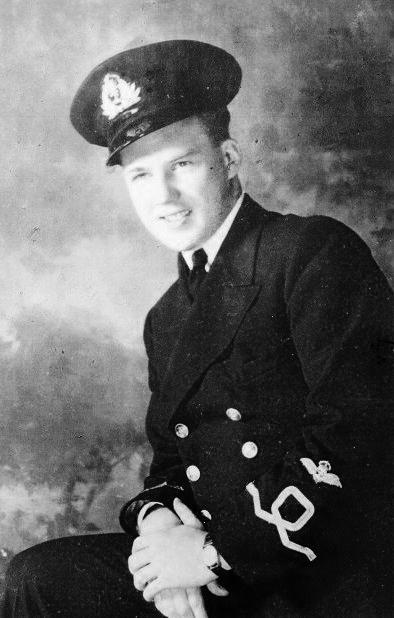
Name:
Rank:
Service:
Awards:
Date of Birth:
Place of Birth:
Date of Enlistment:
Place of Enlistment:
Address at Enlistment:
Age at Enlistment:
Height:
Complexion:
Eye Colour:
Hair Colour:
Marital Status:
Trade:
Religion:
Next of Kin:
Date of Death:
Age at Death:
Cemetery:
Reference:
Robert Hampton Gray
Lieutenant
Royal Canadian Naval Volunteer Reserve
HMS Formidable
Mentioned in Dispatches (January 16, 1945)
Distinguished Service Cross (August 21, 1945)
Victoria Cross (Posthumous) November 13, 1945
November 2, 1917
Trail, British Columbia
July 18, 1940
Calgary, Alberta
Nelson, British Columbia
22
5 feet, 9 inches
Fresh
Blue
Fair
Single
University Student
Presbyterian
John Balfour Gray (Father) Nelson, British Columbia
August 9, 1945
27
Halifax Memorial, Nova Scotia
Panel 13
Commemorated on Page 520 of the Second World War Book of Remembrance
Displayed in the Memorial Chamber of the Peace Tower in Ottawa on November 3
Robert Hampton Gray was the son of John Balfour and Wilhelmina Gray of Nelson, British Columbia,
brother of Phyllis Gray-Gautschi of Nelson, British Columbia and John (Jack) Gray who died on February
27, 1942 while serving with the Royal Canadian Air Force.
The mention in Dispatches reads: “for undaunted courage, skill and determination in carrying out
daring attacks on the German Battleship Admiral von Tirpitz in August 1944”
The Victoria Cross was awarded: “For great valour in leading an attack on a Japanese destroyer in
Onagawa Wan on 9th August, 1945. In the face of fire from shore batteries and a heavy concentration of
fire from some five warships, Lieutenant Gray pressed home his attack, flying very low in order to
ensure success. Although he was hit and his aircraft was in flames, he obtained at least one direct hit,
sinking the destroyer. Lieutenant Gray constantly showed a brilliant fighting spirit and most inspiring
leadership.”
The Victoria Cross was the first one ever to be awarded to a member of the Canadian Navy.
Additional Information: The Last Canadian VC - Robert Hampton Gray
Canadian Virtual War Memorial
Coast Mountain News
Known as ‘Hammy’, his naval career started when as a third year student at the University of British Columbia, in
Vancouver. He was selected as one of seventy-five candidates to go to Great Britain to train for eventual commission. The
candidates were drawn from all parts of Canada and first became acquainted when they boarded the train at Montreal for Halifax
in July 1940. They began their training as ordinary seamen in Halifax and then went overseas to continue their training.
Nineteen of them close to serve with the Fleet Air Arm. Four became observers and twelve became pilots. Hammy Gray was one
of the twelve pilots who received much of their flying training at Collins Bay, near Kingston, Ontario.
Lieutenant Gray served for several months at Nairobi, in Kenya. East Africa. Friends spoke of his great impatience and
biotter disappointment when his time of service there ended without the Japanese fleet making its appearance off the African
coast, as been anticipated.
Early in 1944, Lieutenant Gray returned to Canada on foreign service leave. On his return to the United Kingdom he was
assigned to a Corsair Squadron as senior pilot on HMS Formidable.
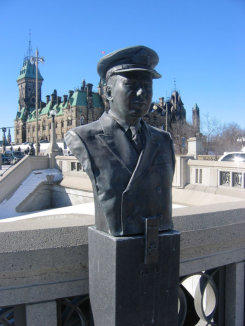
A bust of Gray is one of 14 life-size statues
and busts unveiled in downtown Ottawa in
2006 as part of The Valiants Memorial, which
depicts key figures from Canada’s military
history.
Victoria Cross

A granite cairn overlooking Onagawa Bay
where his Corsair crashed, is the only
known instance of a monument in Japan
honouring an Allied serviceman.
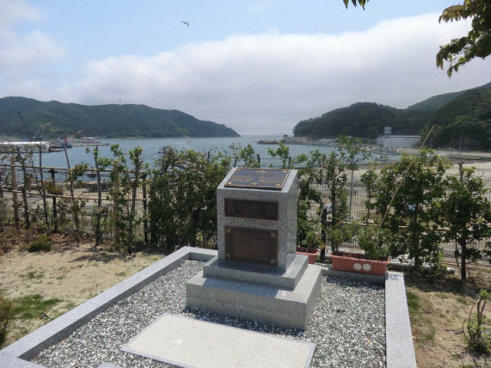
In 2021 a new Monument at North Saanich’s BC Aviation Museum honours Robert Hampton Gray. The monument itself consists of
two black pillars of granite flanking a central pillar of gray polished granite. The right pillar features the last picture of Gray in
his lieutenant’s uniform, while the left pillar features an artist’s rendering of Gray’s final attack. The central pillar records Gray’s
title, awards, decorations and history.
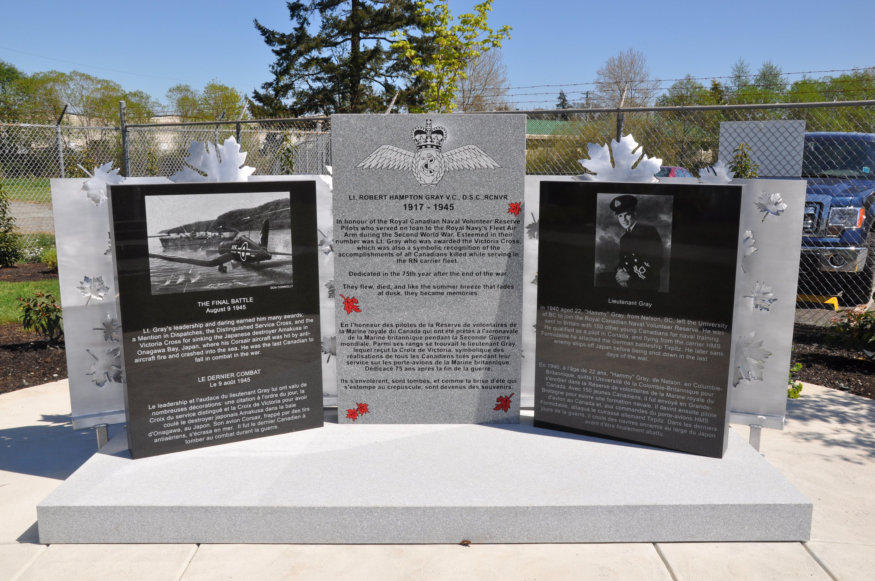
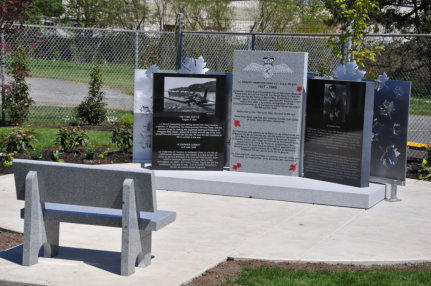
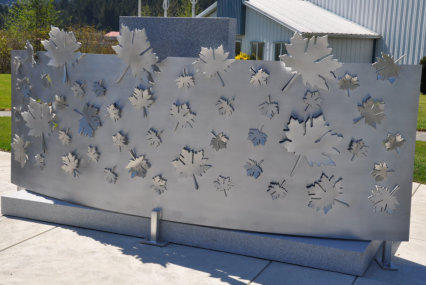
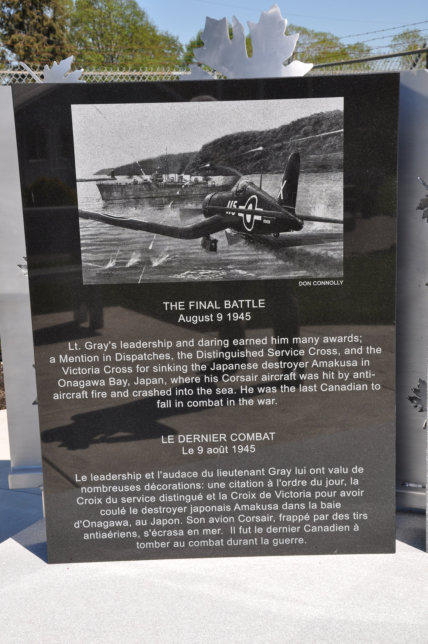
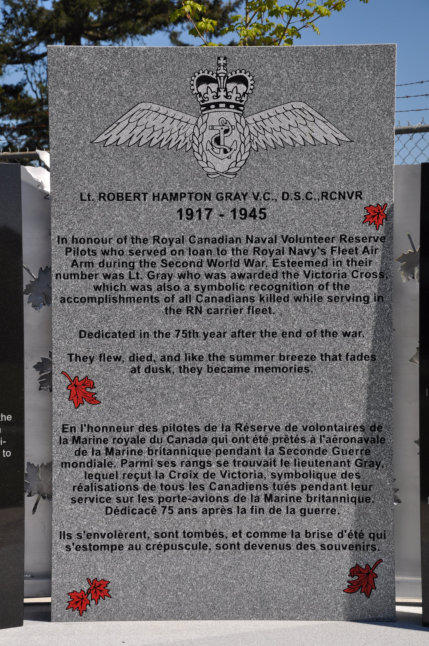
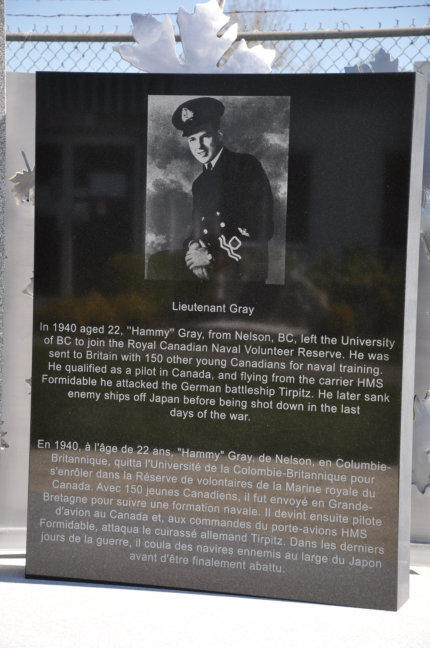
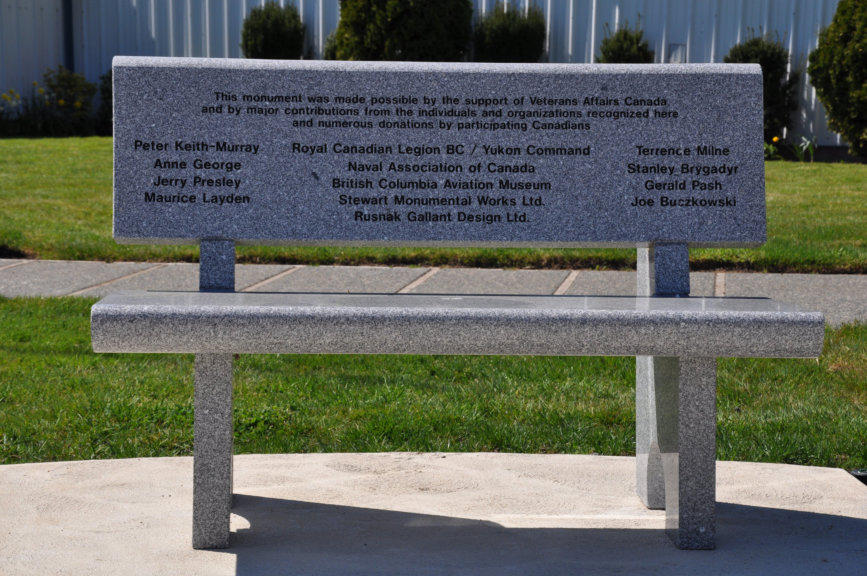
Photos provided courtesy of Gerald W. Pash. (April 2021)


- World War I - Menu
- WWI Stories and Articles
- Photos - Yarmouth Soldiers
- Selection of World War I Songs
- WWI Casualties of Yarmouth, NS
- Those Who Served - Yarmouth, NS
- WWI Casualties Digby Co. NS
- WWI Casualties Shelburne Co. NS
- Merchant Mariners (1915) Yarmouth, NS
- Canadian Forestry Corps - Non Yarmouth Birth/Residence Enlistments
- US Draft Registry - Yarmouth NS Born


- World War II - Menu
- WWII Stories and Articles
- Telegraphist Air Gunners
- WWII Casualties of Nova Scotia
- US Casualties with NS Connection
- Far East/Pacific Casualties with NS Connection
- Merchant Navy Casualties Nova Scotia
- Nova Scotia WWII Casualties Holten Canadian War Cemetery
- D-Day Casualties - Nova Scotia
- CANLOAN Program Casualties - Nova Scotia
- Battle of the Bulge Casualties - Nova Scotia
- WWII Casualties Yarmouth NS
- Yarmouth Casualties - RCAF RAF Canadian Army WWII
- Yarmouth Co., Marrages WWII
- Casualties Non-Born/Residents with Connection to Yarmouth Co., Nova Scotia.
- WWII Casualties Digby Co., NS
- Non-Nova Scotian WWII Casualties Buried in Nova Scotia
- WWII RCAF Casualties Aged 16-18
- Brothers/Sisters Who Served - World War II













